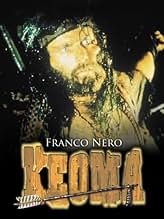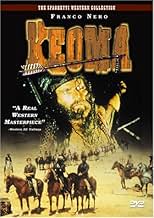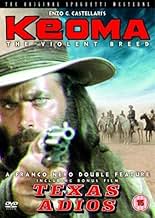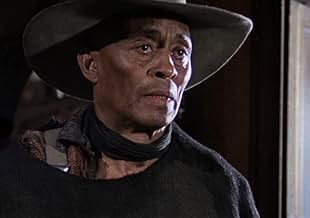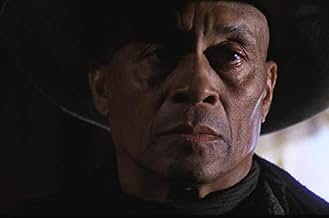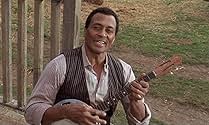IMDb-BEWERTUNG
7,0/10
6581
IHRE BEWERTUNG
Ein ehemaliger Revolverheld versucht, seine von der Pest heimgesuchte Heimatstadt vor der Übermacht seiner rassistischen Halbbrüder und eines konföderierten Tyrannen zu schützen.Ein ehemaliger Revolverheld versucht, seine von der Pest heimgesuchte Heimatstadt vor der Übermacht seiner rassistischen Halbbrüder und eines konföderierten Tyrannen zu schützen.Ein ehemaliger Revolverheld versucht, seine von der Pest heimgesuchte Heimatstadt vor der Übermacht seiner rassistischen Halbbrüder und eines konföderierten Tyrannen zu schützen.
Joshua Sinclair
- Sam Shannon
- (as John Loffredo)
Donald O'Brien
- Caldwell
- (as Donald O'Brian)
Leonardo Scavino
- Doctor
- (as Leon Lenoir)
Antonio Basile
- Caldwell's Henchman
- (Nicht genannt)
Giovanni Bonadonna
- Caldwell's Henchman
- (Nicht genannt)
Armando Bottin
- Caldwell's Henchman
- (Nicht genannt)
Aldo Canti
- Wagon Fugitive
- (Nicht genannt)
- …
Felice Ceciarelli
- Caldwell's Henchman
- (Nicht genannt)
Empfohlene Bewertungen
A half-breed Indian Keoma returns back to his hometown after fighting in the Civil War, and finds his town is being run by an ex-Confederate soldier Caldwell and his outlaws. He holds power over the town by letting the plague infect the inhabitants, and since he won't let any sort of treatment be transported in. He sets up a community for those infected, and this where Keoma rescues a pregnant woman on her way there and returns her back to town. His three half-brothers have joined Caldwell, and I don't think that highly of their brother's return. But loyalty to their father, they won't kill him. His father William Shannon and former family servant/only friend George eventually join Keoma to break the strangle hold Caldwell possess.
Whoa! How good? Real good. Director Enzo G. Castellari's grand looking and interesting spaghetti western comes across as a powerful and beautifully constructed Greek tragedy with a cynical and almost psychological edge bound to it. There's a bit everything chucked into this passionate and intelligent exercise. Breathing high on mood and atmosphere, photographer Aiace Parolin exquisitely frames the mercilessly brooding locations and Castellari's stylishly first-rate direction keeps the film sombre with a brutally unsparing and dirt-laced tone in its dramatic images and context. Good use of abstract lighting and composition, he knows how to keep the viewer at bay with slam-bang set pieces towards the end and a downbeat undercurrent. Inventive framing and exposition also shows the quality of his direction. The glorious slow-motion shootouts and editing technique (ala Sam Peckinpah) are dazzling and how about the constant jumping or leaping in the air. Was there a hidden trampoline on set?! Everything about it held a nice rhythm to it and you just get swept along. Even the flashback sequences are positioned in the story accordingly and in a fulfilling style. The lyrical story is full of symbolic and thematic issues (freedom being the main focal point) that do pack a punch, but also showing a vulnerable side. This gave it a real singular vibe to set it apart from the crowd. Hell, I didn't mind the uncanny and soaring ballad soundtrack too. The way it actually interlocked with the film's sequences, I thought it gave the film some soul and a backbone (well other than always charismatically reliable Nero). A rugged Franco Nero was outstanding. Both mentally and psychically in his scrappy determination and seldom figure Keoma. The impressively committed Woody Strode was excellent. William Berger brought class, and Olga Karlatos decently balanced out an innocent side that really was moving. Donald O'Brien nails it down in a starch turn as the villainous Caldwell.
Whoa! How good? Real good. Director Enzo G. Castellari's grand looking and interesting spaghetti western comes across as a powerful and beautifully constructed Greek tragedy with a cynical and almost psychological edge bound to it. There's a bit everything chucked into this passionate and intelligent exercise. Breathing high on mood and atmosphere, photographer Aiace Parolin exquisitely frames the mercilessly brooding locations and Castellari's stylishly first-rate direction keeps the film sombre with a brutally unsparing and dirt-laced tone in its dramatic images and context. Good use of abstract lighting and composition, he knows how to keep the viewer at bay with slam-bang set pieces towards the end and a downbeat undercurrent. Inventive framing and exposition also shows the quality of his direction. The glorious slow-motion shootouts and editing technique (ala Sam Peckinpah) are dazzling and how about the constant jumping or leaping in the air. Was there a hidden trampoline on set?! Everything about it held a nice rhythm to it and you just get swept along. Even the flashback sequences are positioned in the story accordingly and in a fulfilling style. The lyrical story is full of symbolic and thematic issues (freedom being the main focal point) that do pack a punch, but also showing a vulnerable side. This gave it a real singular vibe to set it apart from the crowd. Hell, I didn't mind the uncanny and soaring ballad soundtrack too. The way it actually interlocked with the film's sequences, I thought it gave the film some soul and a backbone (well other than always charismatically reliable Nero). A rugged Franco Nero was outstanding. Both mentally and psychically in his scrappy determination and seldom figure Keoma. The impressively committed Woody Strode was excellent. William Berger brought class, and Olga Karlatos decently balanced out an innocent side that really was moving. Donald O'Brien nails it down in a starch turn as the villainous Caldwell.
I have to pretty much agree with the two negative reviews below, and I'll explain why in a minute.
Franco Nero plays "Keoma" a half-breed Indian raised by a white man named Shannon (William Berger) who also has three sons (adoptive brothers of Keoma) who hate him and have never accepted a 'half-breed' as their brother.
There's also George (Woody Strode), an ex-slave and friend of Shannon's who teaches Keoma all he knows about fighting.
Cut 20 years later after some flashbacks and Keoma returns to the town near where he was raised and finds that a plague has engulfed the town with a quarantine imposed by a wealthy mine owner Caldwell (Donald O'Brien) who would just as soon have it's inhabitants all die off so he can fully control the area. Keoma steps in to save a pregnant woman who Caldwell's men suspect as a plague carrier and all hell breaks loose.
Yeah, some of the knife throwing does look ludicrous, but the fist fights look good and there's an excellent gun battle in town between Keoma, Shannon and George vs. Caldwell's men. It's really done well and it looks like it was filmed in the same western set built outside of Rome as DJANGO was ten years earlier. By this time though, the place looks pretty run down and cluttered which makes a good setting for a plague-infested town.
As far as negatives go, the music sucks. It's an annoying high pitch (mostly female) whine that appears periodically throughout the move, inter sprinkled with 'singing' done by Franco Nero himself. It sounds awful as he tries to imitate Leonard Cohen but winds up sounding like a lame Tom Waits. I don't know why anybody likes it. To each his own, I guess.
There's also the annoying Sam Peckinpah-like slow-motion effects that become a cliché used over and over. It ruins some of the great gunfights, especially at the end where Keoma is battling his brothers in a barn while the pregnant lady's screams drown out all the gun battle sound. A little too arty for my tastes.
The dubbing is OK and it sounds like Nero dubbed in his own voice which comes off as strange and foreign for a half-breed American Indian. I suppose one gets used to it as the film goes along.
The Anchor Bay DVD uses an anamorphic widescreen print that looks pretty good. Only a few scratches during the opening and closing titles. No closed captioning. Nero also does a 10 minute interview explaining how the film came about, along with a secondary audio track by director Enzo Castellari giving details about the filming. Yeah the spaghetti western genre was dead by the time this film was made, but Castellari says it did very well in Italy although not enough to revive the genre. Tastes were moving towards gangsters and crime dramas by the mid-70s, so this film was an exception, not the rule.
It has some good ideas but I wouldn't consider it a masterpiece for the genre or anything. However I did enjoy some of the gun play and fistfights.
6 out of 10
-
Franco Nero plays "Keoma" a half-breed Indian raised by a white man named Shannon (William Berger) who also has three sons (adoptive brothers of Keoma) who hate him and have never accepted a 'half-breed' as their brother.
There's also George (Woody Strode), an ex-slave and friend of Shannon's who teaches Keoma all he knows about fighting.
Cut 20 years later after some flashbacks and Keoma returns to the town near where he was raised and finds that a plague has engulfed the town with a quarantine imposed by a wealthy mine owner Caldwell (Donald O'Brien) who would just as soon have it's inhabitants all die off so he can fully control the area. Keoma steps in to save a pregnant woman who Caldwell's men suspect as a plague carrier and all hell breaks loose.
Yeah, some of the knife throwing does look ludicrous, but the fist fights look good and there's an excellent gun battle in town between Keoma, Shannon and George vs. Caldwell's men. It's really done well and it looks like it was filmed in the same western set built outside of Rome as DJANGO was ten years earlier. By this time though, the place looks pretty run down and cluttered which makes a good setting for a plague-infested town.
As far as negatives go, the music sucks. It's an annoying high pitch (mostly female) whine that appears periodically throughout the move, inter sprinkled with 'singing' done by Franco Nero himself. It sounds awful as he tries to imitate Leonard Cohen but winds up sounding like a lame Tom Waits. I don't know why anybody likes it. To each his own, I guess.
There's also the annoying Sam Peckinpah-like slow-motion effects that become a cliché used over and over. It ruins some of the great gunfights, especially at the end where Keoma is battling his brothers in a barn while the pregnant lady's screams drown out all the gun battle sound. A little too arty for my tastes.
The dubbing is OK and it sounds like Nero dubbed in his own voice which comes off as strange and foreign for a half-breed American Indian. I suppose one gets used to it as the film goes along.
The Anchor Bay DVD uses an anamorphic widescreen print that looks pretty good. Only a few scratches during the opening and closing titles. No closed captioning. Nero also does a 10 minute interview explaining how the film came about, along with a secondary audio track by director Enzo Castellari giving details about the filming. Yeah the spaghetti western genre was dead by the time this film was made, but Castellari says it did very well in Italy although not enough to revive the genre. Tastes were moving towards gangsters and crime dramas by the mid-70s, so this film was an exception, not the rule.
It has some good ideas but I wouldn't consider it a masterpiece for the genre or anything. However I did enjoy some of the gun play and fistfights.
6 out of 10
-
Though to be clear I wouldn't go as far as to call it "the best". Something the people involved are quick to point out or to. This is really good and you have a very charismatic (and hairy chested) Franco Nero starring. You also have supernatural elements, that may not be fully explained (not even by all the extras on the disc).
And you have old school shooutous, where bad guys seem to only need one bullet to bite the dust (literally), whereas good people have to be shot quite a few times mostly. So yes there are things that may seem or feel dated, but the overall sense is quite great. Not to mention the performances. Really telling and really inspired overall.
And you have old school shooutous, where bad guys seem to only need one bullet to bite the dust (literally), whereas good people have to be shot quite a few times mostly. So yes there are things that may seem or feel dated, but the overall sense is quite great. Not to mention the performances. Really telling and really inspired overall.
This film has so much that works so well, it's a shame one thing keeps it from working entirely l: the music. The single most annoying song I've ever heard in a film. Secondly the newest "restored" version inexplicably has two totally different English voices dubbed for Nero. His first few lines are delivered in a deep clear "radio announcer" pure English baritone, the rest of the film is in a poorly faked accent. What exactly would be the reason for this? Other than those two distractions, a great late era entry to the genre.
Castellari's Keoma was part of the late 1970's second wave of spaghetti westerns. It is typically considered one of the better entries in the genre, some even rate it as a classic alongside Leone's masterpieces. However, while it has clearly been attempted to make the film look stylish and sophisticated, and at a casual glance it does look pretty well made, a more in depth look shows that it falls quite a long way off the mark.
Basically, it's clear that what Castellari has is a bunch of director's tricks up his sleeve - slow motion, unconventional camera angles, subtle merges into flashbacks and so on - all of them thieved from the work of other filmmakers. That in itself is no bad thing - after all Tarantino has made a career out of doing the same - but the difference is that Castellari clearly has no idea how and when to use these techniques. He simply throws them in at every opportunity, so that they actually stick out rather than enhance the film. The most obvious example is the Sam Peckinpah style slow motion deaths after someone is shot. In Peckinpah's films it was used skilfully to highlight the brutality of certain killings here and there throughout the movie. In Keoma it is used more or less every time someone is shot - about forty or fifty altogether - totally losing any impact it might have had.
Add to this that Keoma is a completely boring spaghetti western character - basically just a hippy with a colt - and not one of Franco Nero's better performances. The dialogue is terrible. The plot is text book spaghetti western back-for-revenge. This movie doesn't really have a lot going for it.
And then there is the music, famous itself among spaghetti western fans for being almost unlistenably bad, which seems to sum up the feeling of the entire film. Quite a nice melody, but either sung in a piercing shriek by the female vocalist or an unnerving growl by the male vocalist.
In short Keoma is a perfect example of style over substance - it's all dazzling flair in an attempt to cover up a pretty poor film. Viewers should stick to the real classic spaghettis like Sergio Leone and Sergio Corbucci's work.
Basically, it's clear that what Castellari has is a bunch of director's tricks up his sleeve - slow motion, unconventional camera angles, subtle merges into flashbacks and so on - all of them thieved from the work of other filmmakers. That in itself is no bad thing - after all Tarantino has made a career out of doing the same - but the difference is that Castellari clearly has no idea how and when to use these techniques. He simply throws them in at every opportunity, so that they actually stick out rather than enhance the film. The most obvious example is the Sam Peckinpah style slow motion deaths after someone is shot. In Peckinpah's films it was used skilfully to highlight the brutality of certain killings here and there throughout the movie. In Keoma it is used more or less every time someone is shot - about forty or fifty altogether - totally losing any impact it might have had.
Add to this that Keoma is a completely boring spaghetti western character - basically just a hippy with a colt - and not one of Franco Nero's better performances. The dialogue is terrible. The plot is text book spaghetti western back-for-revenge. This movie doesn't really have a lot going for it.
And then there is the music, famous itself among spaghetti western fans for being almost unlistenably bad, which seems to sum up the feeling of the entire film. Quite a nice melody, but either sung in a piercing shriek by the female vocalist or an unnerving growl by the male vocalist.
In short Keoma is a perfect example of style over substance - it's all dazzling flair in an attempt to cover up a pretty poor film. Viewers should stick to the real classic spaghettis like Sergio Leone and Sergio Corbucci's work.
Wusstest du schon
- WissenswertesThe story line of the film was mostly improvised at the same time as the film was made. The original story treatment was written by Luigi Montefiori (aka George Eastman) and turned into a script by Mino Roli and Nico Ducci, but director Enzo G. Castellari didn't like what had been written by the latter two. Because of problems with the schedule, Castellari and actor Joshua Sinclair wrote the script for the next day every evening after filming of the day. Castellari was also open to suggestions from the cast and crew - Franco Nero has confirmed that he wrote some of his own dialogue.
- PatzerAt 7:08 riders on horseback in pursuit of two men running on foot fire their pistols. Both men on foot react as if hit by the first shot.
- Alternative VersionenGerman version was cut for violence and pacing reasons by 8 minutes to secure a "not under 16" rating. Despite that, it still got put on the index list by the BPjM which means various sales and advertising restrictions. Fortunately in 2003, the movie was removed from the index list and the FSK granted the uncut version a "not under 16" rating.
- VerbindungenFeatured in L'oeil du cyclone: Westernissimo (1995)
- SoundtracksKeoma
(uncredited)
Music by Guido De Angelis & Maurizio De Angelis
Lyrics by Susan Duncan Smith and Cesare De Natale
Performed by Sibyl Mostert and Cesare De Natale
Top-Auswahl
Melde dich zum Bewerten an und greife auf die Watchlist für personalisierte Empfehlungen zu.
- How long is Keoma?Powered by Alexa
Details
Zu dieser Seite beitragen
Bearbeitung vorschlagen oder fehlenden Inhalt hinzufügen


